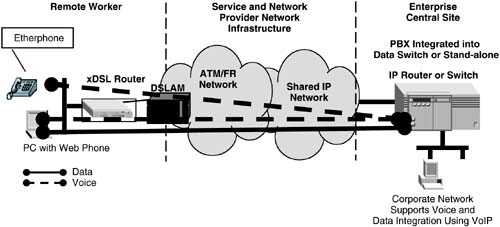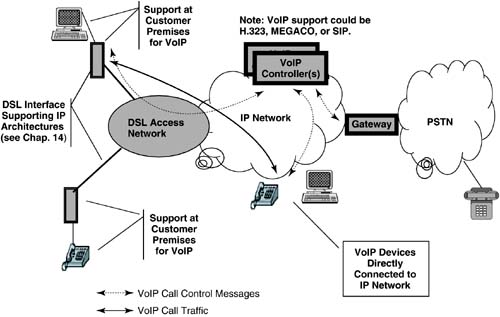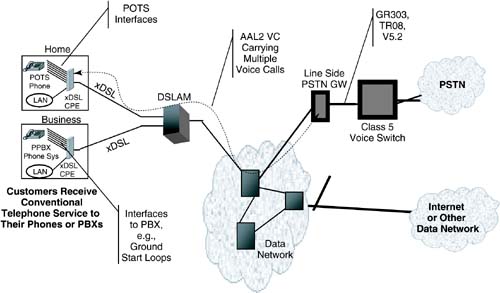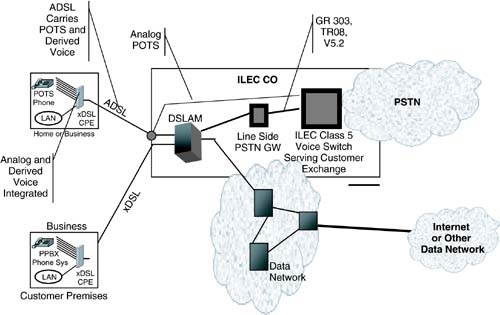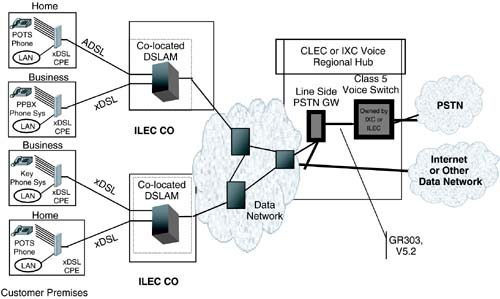16.5 The Appeal of Voice-over DSL
| There are at least three distinct service opportunities provided by VoDSL: loop extension, PBX extension, and access to packetized voice networks. Although each of these opportunities will require different end-to-end architectures to implement them, they all will use the basic functionality of DSL to support simultaneous access for digitized voice and data. The last two of these opportunities can be supported by DSL access using enhancements to DSL functionality that are already planned for other purposes. However, loop extension requires CPE with capabilities specifically developed to support the service. By use of the DSL physical access and a broadband network, home offices and small branch offices are given remote access to a corporate voice network. The goal is to extend these private voice networks in cost-effective ways to the smallest sites and to increase the integration available to telecommuters. Figure 16.14 is a schematic architecture for this service. Figure 16.14. PBX extension architecture. A PBX supporting a packet voice interface, either VoIP, VoFR (voice-over frame relay), or VoATM is connected to a remote site over a broadband network and a DSL access. The remote device may be a remote extension to the PBX to allow a teleworker to have seamless access to the corporate PBX, in which case a line-side interface is abstracted from the PBX. In other cases a branch PBX at the remote site is connected to the corporate voice network over the DSL access using the packetized voice as a trunk-side interface. The remote user may also access the corporate data network over a VPN. Functions such as support for VPN and IPsec, QoS on the LAN (via protocols such as 801.2p/q), and QOS on the WAN (using protocols such as Diffserv) are required in the DSL CPE to support this service effectively. As these features are delivered, it will be possible to provide secure and high-quality remote PBX access as an integral part of a DSL data service to any telecommuter or small branch office. 16.5.1 Access to Packetized Voice NetworksNew voice and multimedia architectures as discussed in Section 16.4 will provide backbones to support voice services based on VoIP and VoATM. The new broadband access methods will provide direct access to these networks from home LANs and small businesses. Interworking between these new networks and the traditional PSTN will likely occur on "trunk side" interfaces, while the function of today's class 5 voice switch will be distributed within an IP- or ATM-based network. DSL will provide broadband service to the home, multidwelling units, and small business to allow access to these networks, providing converged support for both data and voice. Figure 16.15 illustrates the architecture for DSL access to a network based on VoIP. Figure 16.15. Access to packetized voice architectures. As with use of DSL to support PBX extension, much of the functionality required to support this type of service over DSL access will be developed as part of the natural planned enhancement of DSL CPE and network equipment. 16.5.2 Loop ExtensionThis service provides a high-quality emulation of POTS, or even ISDN service, to the end user, including the ability of the user to make use of their existing analog telephone equipment, small PBX, or key systems. All existing switched-based voice services such as CLASS and IN services will be supported transparently . The voice is digitized in an interworking device at the customer's premises and is multiplexed over ATM or packet with the user's data on the DSL physical access. The interworking with the PSTN occurs with a "line side" interface to a class 5 voice switch, such as GR-303, TR-08, or V5.2. The class 5 switch provides the telephony functionality and sees the gateway as a digital loop carrier system. The broadband data network carries the voice traffic to a centralized line side gateway that interworks with a class 5 switch. The line side gateway appears to the class 5 voice switch as a if it were a digital loop carrier supported by either the TR-08 [9] or GR-303 (or outside North America V5.2) interfaces. Architectures like those shown in Figure 16.16, where the gateway functionality is integrated into the class 5 voice switch may be especially attractive to CLECs. Figure 16.16. CLEC or IXE implementation of loop extension. If the case of an ILEC architecture like that in Figure 16.17 is possible, the incumbent telco already has a voice switch in every CO. Figure 16.17. Loop extension architecture for an ILEC. In the case of a CLEC, an architecture like that in Figure 16.18 may be desirable, as the CLECs can aggregate traffic to a centralized switch serving several COs. Architectures where the gateway is integrated into the DSLAM or both gateway and DSLAM functionality are integrated into a digital loop carrier system may be especially attractive to ILECs. Figure 16.18. Loop extension architecture for CLEC. |
| Top |
EAN: 2147483647
Pages: 154
